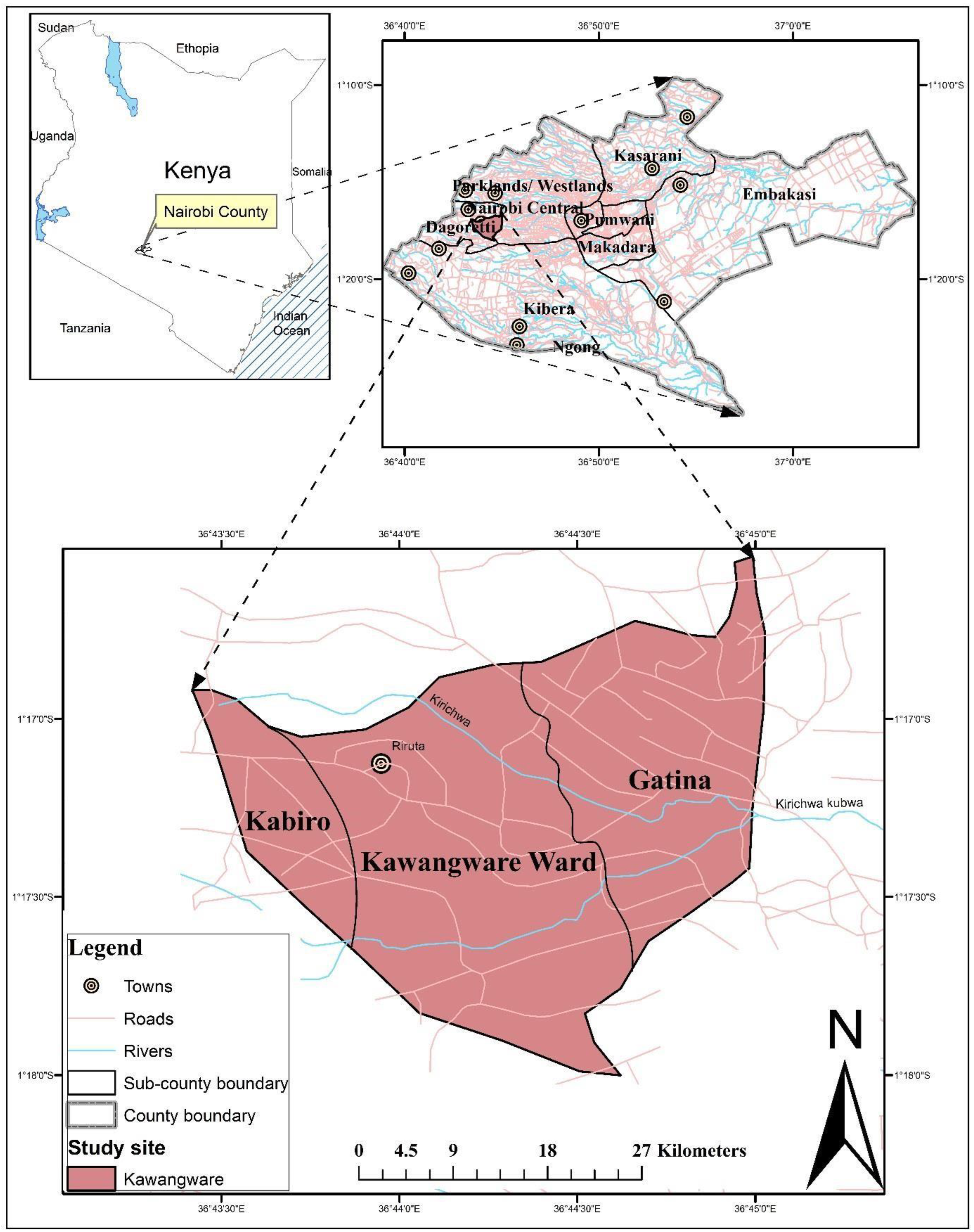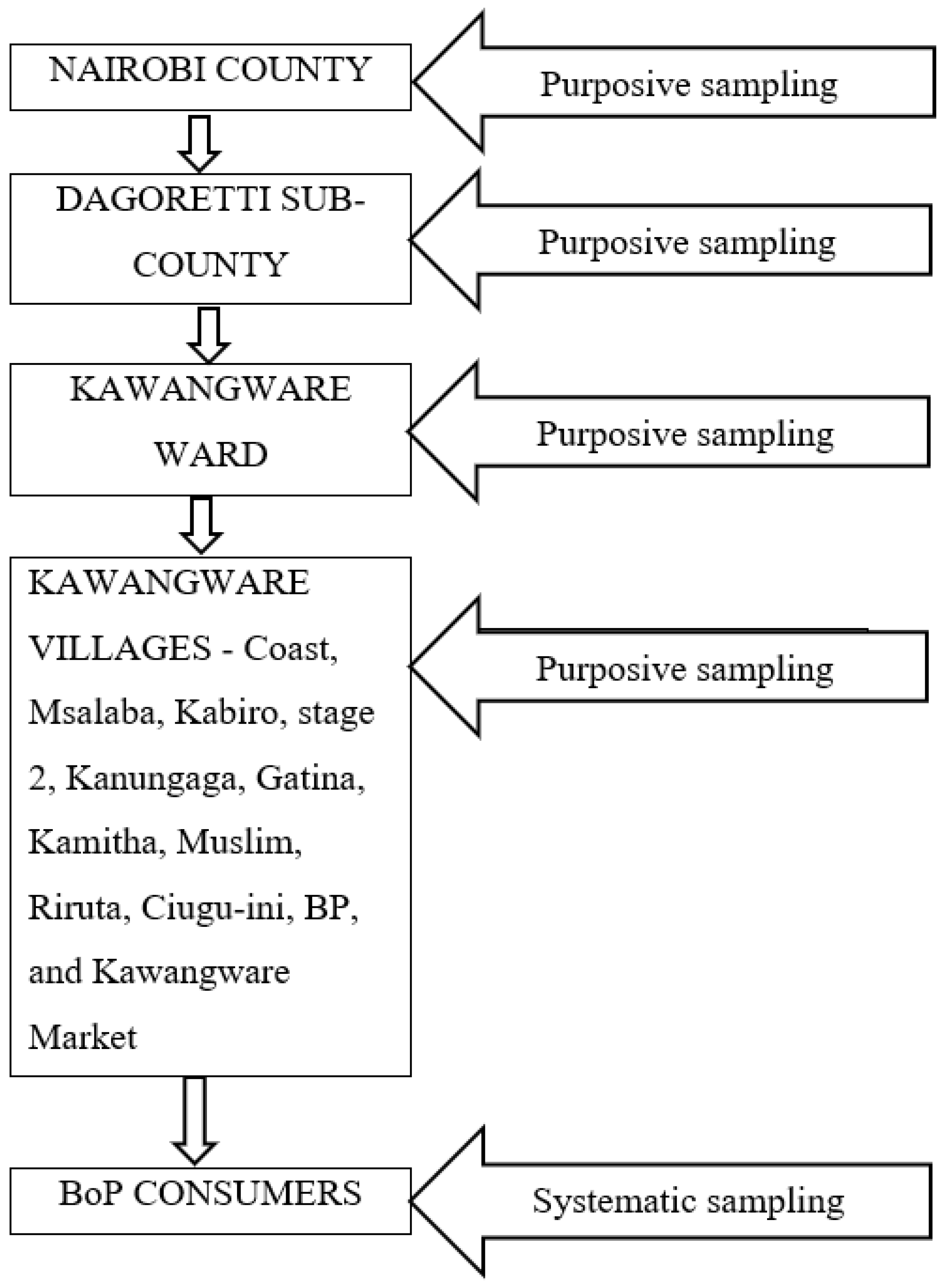Which Food Outlets Are Important for Nutrient-Dense-Porridge-Flour Access by the Base-of-the-Pyramid Consumers? Evidence from the Informal Kenyan Settlements
Abstract
1. Introduction
2. Materials and Methods
2.1. Study Area
2.2. Sampling Procedure
2.3. Econometric Model
3. Results and Discussions
3.1. The Most Effective Outlet for the Supply of Nutrient-Dense Porridge Flour to BoP Consumers
3.2. Factors Influencing the Choice of Outlets among the BoP Consumers
4. Conclusions
Author Contributions
Funding
Institutional Review Board Statement
Informed Consent Statement
Data Availability Statement
Acknowledgments
Conflicts of Interest
References
- Food and Agriculture Organization. Expert Consultation on Nutrition Indicators for Biodiversity (Report No. 2); Food and Agriculture Organization of the United Nations: Rome, Italy, 2017. [Google Scholar]
- Joachim, B.; Regina, B. Designing Global Governance for Agricultural Development and Food and Nutrition Security. Rev. Dev. Econ. 2016, 21, 265–284. [Google Scholar]
- World Bank. Poverty and Shared Prosperity 2018: Piecing together the Poverty Puzzle; World Bank: Washington, DC, USA, 2018. [Google Scholar]
- Opiyo, P.O.; Ogindo, H.O. The characteristics of the urban food system in Kisumu, Kenya. In Urban Food Systems Governance and Poverty in African Cities; Routledge: London, UK, 2019; pp. 182–194. [Google Scholar]
- GoK. Kenya Food Security Outlook Update. 2018. Available online: http://www1.wfp.org/countries/kenya (accessed on 23 March 2018).
- Kenya National Bureau of Statistics. Demographic and Health Survey. Key Indicators; Kenya National Bureau of Statistics: Nairobi, Kenya, 2014.
- Amendah, D.; Buigut, S.; Mohamed, S. Coping strategies among urban poor: Evidence from Nairobi, Kenya. PLoS ONE 2014, 9, e83428. [Google Scholar] [CrossRef] [PubMed]
- Wiesmann, U.M.; Kiteme, B.; Mwangi, Z. Socio-Economic Atlas of Kenya: Depicting the National Population Census by County and Sub-Location; Kenya National Bureau of Statistics, Centre for Training and Integrated Research in ASAL Development, Centre for Development and Environment: Nairobi, Kenya, 2014. [Google Scholar]
- Chege CG, K.; Namazzi, S.; Mutua, M.M.; Onyango, K.O.; Jager, M. What determines consumption of nutritious foods by the urban poor in Africa? Br. Food J. 2021, 124, 350–365. [Google Scholar] [CrossRef]
- Martin, N.; Felicity, M. Nutrition Survey Conducted in the Slums of Nairobi County; Nutrition Health: Nairobi, Kenya, 2017. [Google Scholar]
- World Food Organization. The State of Food Security and Nutrition in the World; Building Resilience for Peace and Food Security: Rome, Italy, 2017. [Google Scholar]
- Wenban-Smith, H.; Fasse, A.; Grote, U. Food security in Tanzania: The challenge of rapid urbanisation. Food Secur. 2016, 8, 973–984. [Google Scholar] [CrossRef]
- Gelli, A.; Hawkes, J.; Donovan, J.; Harris, A.; Summer, A.; Brauw, S.; Henson, N.; Johnson, J.; Ryckembusch, D. Value Chains and Nutrition: A Framework to Support the Identification, Design, and Evaluation of Interventions; IFPRI Discussion Paper 01413; International Food Policy Research Institute: Washington, DC, USA, 2015. [Google Scholar]
- Hawkes, C.; Ruel, M. Value Chains for Nutrition. In Proceedings of the 2020 Conference: Leveraging Agriculture for Improving Nutrition and Health, New Delhi, India, 10–12 February 2011; Conference Paper 4. International Food Policy Research Institute: Washington, DC, USA, 2011. [Google Scholar]
- Tacoli, C. Food (in) security in rapidly urbanising, low-income contexts. Int. J. Environ. Res. Public Health 2017, 14, 1554. [Google Scholar] [CrossRef] [PubMed]
- Kenya National Bureau of Statistics. Economic Survey; Kenya National Bureau of Statistics: Nairobi, Kenya, 2021.
- Chege, C.G.; Andersson, C.I.; Qaim, M. Impacts of supermarkets on farm household nutrition in Kenya. World Dev. 2015, 72, 394–407. [Google Scholar] [CrossRef]
- Kayser, O.; Klarsfeld, L.; Brossard, S. The Broadband Effect: Enhancing Marketbased Solutions for the Base of the Pyramid; Inter-American Development Bank: Washington, DC, USA, 2014. [Google Scholar]
- Demmler, K.M.; Ecker, O.; Qaim, M. Supermarket shopping and nutritional outcomes: A panel data analysis for urban Kenya. World Dev. 2018, 102, 292–303. [Google Scholar] [CrossRef]
- Van Dijk, N.; van der Velde, N.; Macharia, J.; Pipim, K.N.; Shimeles, H. Innovating at Marketing and Distributing Nutritious Foods at the Base of the Pyramid (BoP): Insights from 2SCALE, the Largest Incubator for Inclusive Agribusiness in Africa. In The Innovation Revolution in Agriculture; Springer: Cham, Switzerland, 2021; pp. 147–177. [Google Scholar]
- Mensah, D.O.; Oyebode, O. “We think about the quantity more”: Factors influencing emerging adults’ food outlet choice in a university food environment, a qualitative enquiry. Nutr. J. 2022, 21, 49. [Google Scholar] [CrossRef] [PubMed]
- Hazel, L.; Suneetha, K.; Agnes, R.; Kenda, C.; Parul, T. Women’s Empowerment Mitigates the Negative Effects of Low Production Diversity on Maternal and Child Nutrition in Nepal. J. Dev. Stud. 2015, 51, 1097–1123. [Google Scholar]
- Kenya National Bureau of Statistics; ICF Macro. Kenya Demographic and Health Survey Key Indicators; Kenya National Bureau of Statistics: Nairobi, Kenya, 2015.
- Ongosi, N.; Gericke, G.; Mbuthia, E.; Oelofse, A. Food variety, dietary diversity and perceived hunger among lactating women (0–6 months postpartum) in a low socio-economic area in Nairobi, Kenya. Afr. J. Online 2014, 4, 1684–5374. [Google Scholar] [CrossRef]
- African Population & Health Research Center. Population and Health Dynamics in Nairobi’s Informal Settlements: Report of the Nairobi Cross-Sectional Slums Survey (NCSS) 2012; African Population and Health Research Centre: Nairobi, Kenya, 2012. [Google Scholar]
- Fischer, S. On the need for an international lender of last resort. J. Econ. Perspect. 1999, 13, 85–104. [Google Scholar] [CrossRef]
- Kenya National Bureau of Statistics (KNBS); ICF Macro. Kenya Demographic and Health Survey 2008–2009; KNBS and ICF Macro: Calverton, NY, USA, 2010.
- Chib, S.; Greenberg, E. Analysis of multivariate probit models. Biometrika 1998, 85, 347–361. [Google Scholar] [CrossRef]
- Rose, D.; Bodor, N.; Hutchinson, L.; Swalm, M. The importance of a multidimensional approach for studying the links between food access and consumption. J. Nutr. 2010, 140, 1170–1174. [Google Scholar] [CrossRef] [PubMed]
- Cappellari, L.; Jenkins, S.P. Multivariate probit regression using simulated maximum likelihood. STATA J. 2003, 3, 278–294. [Google Scholar] [CrossRef]
- Wanyama, R.; Gödecke, T.; Jager, M.; Qaim, M. Poor consumers’ preferences for nutritionally enhanced foods. Br. Food J. 2019, 121, 755–770. [Google Scholar] [CrossRef]
- Ayuya, O.I.; Soma, K.; Obwanga, B. Socio-economic drivers of fish species consumption preferences in Kenya’s urban informal food system. Sustainability 2021, 13, 5278. [Google Scholar] [CrossRef]
- Petrin, A.; Train, K. Omitted Product Attributes in Discrete Choice Models; National Bureau of Economic Research: Cambridge, MA, USA, 2003. [Google Scholar]
- Farrell, J.A.; Cordeiro, L.S.; Qian, J.; Sullivan-Werner, L.; Nelson-Peterman, J.L. Food affordability, food security, and the Expanded Food and Nutrition Education Program. J. Hunger. Environ. Nutr. 2018, 13, 180–191. [Google Scholar] [CrossRef]
- Pryor, S.; Dietz, W. The COVID-19, Obesity, and Food Insecurity Syndemic. Curr. Obes. Rep. 2022, 11, 70–79. [Google Scholar] [CrossRef] [PubMed]
- Ghosh, P.; Tripathi, V.; Kumar, A. Customer expectations of store attributes: A study of organized retail outlets in India. J. Retail. Leis. Prop. 2010, 9, 75–87. [Google Scholar] [CrossRef]
- Herforth, A.; Bai, Y.; Venkat, A.; Mahrt, K.; Ebel, A.; Masters, W.A. Cost and Affordability of Healthy Diets across and within Countries: Background Paper for the State of Food Security and Nutrition in the World 2020; FAO Agricultural Development Economics Technical Study No. 9; Food & Agriculture Organization of the United Nations: Rome, Italy, 2020; Volume 9. [Google Scholar]


| Variable | Abbreviation | Unit of Measurement | Expected Sign |
|---|---|---|---|
| Distance to outlets | DSTNC | Meters | − |
| Household head sex Household income | HHSEX HHINCM | 1 = Male, 0 = Female KES | − + |
| Ready availability | AVLBLTY | 1 = Yes 0 = No | + |
| Consumer credit | CRDTPUR | 1 = Yes 0 = No | + |
| Service mode | SSMDE | 1 = Yes 0 = No | + |
| Convenient operating hours | CNVNCE | 1 = yes 0 = No | + |
| Good hygiene | HYGN | 1 = Yes 0 = No | + |
| Source of the Flour | Freq. | Per Cent | Cum. |
|---|---|---|---|
| Mom-and-pop shop | 11 | 1.82 | 1.82 |
| Kiosk | 117 | 19.40 | 21.23 |
| Supermarket | 308 | 51.08 | 72.31 |
| Vendor | 154 | 25.54 | 97.84 |
| Village health team/counselor | 13 | 2.16 | 100.00 |
| Total | 603 | 100.00 |
| Supermarket | Kiosk | Mom-and-Pop Shop | VHT | Vendor | |
|---|---|---|---|---|---|
| Supermarket | 1.000 | ||||
| Kiosk | −0.439 *** | 1.000 | |||
| Mom-and-pop shop | 0.208 *** | −0.436 *** | 1.000 | ||
| Village health team | −0.124 *** | −0.023 *** | −0.221 *** | 1.000 | |
| Vendor | 0.050 *** | −0.030 *** | 0.070 *** | −0.197 *** | 1.000 |
| Outlets | Supermarket | Kiosk | Vendor | Mom-and-Pop Shop | Village Health Team | |||||
|---|---|---|---|---|---|---|---|---|---|---|
| Variable | Marginal Effects | SE | Marginal Effects | SE | Marginal Effects | SE | Marginal Effects | SE | Marginal Effects | SE |
| Distance to outlets | −0.0004 ** | 0.0001 | 0.0001 | 0.0001 | 0.0001 | 0.00005 | −0.0001 | 0.0001 | −0.0001 | 0.0001 |
| Household head’s sex | 0.5991 | 0.4689 | 0.1384 | 0.1093 | −0.1383 | 0.1136 | 0.0318 | 0.1035 | −0.0890 | 0.1032 |
| Household income | −0.0001 | 0.0001 | 0.0001 | 0.0001 | 0.0001 | 0.0000 | −0.0001 | 0.0000 | 0.0001 | 0.0000 |
| Ready availability | −0.2428 | 0.5300 | 0.1247 | 0.1766 | 0.0777 | 0.1856 | 0.2856 | 0.1756 | 0.1119 | 0.1722 |
| Can purchase on credit | −1.4025 ** | 0.6164 | −0.5677 | 0.4214 | 0.7177 * | 0.4138 | 0.2541 | 0.3884 | 0.4443 | 0.4150 |
| Self-service | 1.6317 ** | 0.8466 | −0.8641 * | 0.4537 | 1.1697 ** | 0.4640 | 0.2048 | 0.4281 | 0.7918 * | 0.4555 |
| Convenient operation hours | −8.1617 | 175.8710 | 0.5327 *** | 0.2164 | −0.2368 | 0.2278 | 0.2539 | 0.2073 | −0.1444 | 0.2022 |
| Hygiene level | −8.5036 | 202.1719 | 0.8887 *** | 0.1690 | 0.0203 | 0.1775 | −0.6794 *** | 0.1680 | 0.3594 ** | 0.1626 |
Publisher’s Note: MDPI stays neutral with regard to jurisdictional claims in published maps and institutional affiliations. |
© 2022 by the authors. Licensee MDPI, Basel, Switzerland. This article is an open access article distributed under the terms and conditions of the Creative Commons Attribution (CC BY) license (https://creativecommons.org/licenses/by/4.0/).
Share and Cite
Koech, K.K.; Chege, C.G.K.; Bett, H. Which Food Outlets Are Important for Nutrient-Dense-Porridge-Flour Access by the Base-of-the-Pyramid Consumers? Evidence from the Informal Kenyan Settlements. Sustainability 2022, 14, 12264. https://doi.org/10.3390/su141912264
Koech KK, Chege CGK, Bett H. Which Food Outlets Are Important for Nutrient-Dense-Porridge-Flour Access by the Base-of-the-Pyramid Consumers? Evidence from the Informal Kenyan Settlements. Sustainability. 2022; 14(19):12264. https://doi.org/10.3390/su141912264
Chicago/Turabian StyleKoech, Kevin Kipkemei, Christine G. Kiria Chege, and Hillary Bett. 2022. "Which Food Outlets Are Important for Nutrient-Dense-Porridge-Flour Access by the Base-of-the-Pyramid Consumers? Evidence from the Informal Kenyan Settlements" Sustainability 14, no. 19: 12264. https://doi.org/10.3390/su141912264
APA StyleKoech, K. K., Chege, C. G. K., & Bett, H. (2022). Which Food Outlets Are Important for Nutrient-Dense-Porridge-Flour Access by the Base-of-the-Pyramid Consumers? Evidence from the Informal Kenyan Settlements. Sustainability, 14(19), 12264. https://doi.org/10.3390/su141912264






